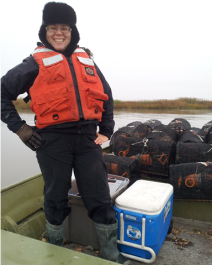TWO LMRCSC STUDENTS SELECTED FOR NOAA EPP/MSI GRADUATE RESEARCH AND TRAINING SCHOLARSHIP PROGRAM
LMRCSC student and current NOAA Graduate Research and Training Scholar Nivette Perez-Perez discusses her research on WDSU’s Inside Perspective, a program of Delaware State University.
Two NOAA LMRCSC students earned Graduate Research & Training Scholarships (GRTSP) from the National Oceanic and Atmospheric Administration (NOAA). Laura Almodóvar-Acevedo, a Ph.D. student in the Marine Estuarine Environmental Sciences Graduate Program at the University of Maryland Eastern Shore (UMES), and Nivette M. Pérez-Pérez, master’s student in the Department of Natural Resources at Delaware State University earned the scholarship.
GRTSP is a pilot program designed to provide opportunities for graduate students that are supported at the Educational Partnership Program with Minority Serving Institutions (EPP/MSI) Cooperative Science Centers, like the LMRCSC, to participate in research at a NOAA facility with guidance from a NOAA mentor. The scholarship provides an annual stipend to support tuition and fees and funds to cover other costs associated with professional development, research travel and presentations at conferences.

Laura Almodóvar-Acevedo is a Ph.D. student in the Marine Estuarine Environmental Sciences Graduate Program, specializing in Ecology, and is an LMRCSC student at UMES.
Almodóvar-Acevedo joined the program in 2013 and will use the funding to expand upon her Ph.D. research, which is focused on black sea bass.
The overall objective of her research project is to expand the knowledge of the importance of the Chesapeake Bay for black sea bass population dynamics. Almodóvar-Acevedo will accomplish this through comprehensive study that incorporates ecosystem modeling, bioenergetics and field sampling.
“The GRTSP will be of great help in the completion of this project and my Ph.D.,” Almodóvar-Acevedo said. “I will be learning not only about my subject but also on how to effectively collaborate with others, how to communicate my research and the intricacies of working in an agency.”
Almodóvar-Acevedo considers the project relevant to NOAA’s mission because it concerns a federally managed fish species that is data poor and focuses on the fish’s nursery habitat preferences in the Chesapeake Bay.
As part of GRTSP, she is looking forward to working in a fisheries or ecosystem services lab and interacting with scientists and expert ecological modelers who can offer guidance and help her develop her work into a robust and effective study.
“Getting the opportunity to study with both financial and academic support from the LMRCSC has been essential to my academic career,” Almodovar-Acevedo said. “The LMRCSC’s connections with NOAA have been useful, and will be in the future.”
After finishing her Ph.D., Almodóvar-Acevedo would like to do a post-doc and then join an agency such as NOAA or as a research professor in a university. She hopes to continue working as a researcher to help answer questions related to marine ecosystems, resilience of species and fisheries impact.
“Ideally, I would like to apply all that I’m learning about marine sciences and management to the Caribbean. There is a lot of research to be done that affect millions of people and a delicate ecosystem,” Almodóvar-Acevedo said.

Nivette M. Pérez-Pérez, LMRCSC graduate student in the Department of Natural Resources at Delaware State University.
Pérez-Pérez aims to work as a NOAA scientist and sees GRTSP as an opportunity to strengthen her network within the scientific community, increase her understanding of the needs and interest of NOAA and become an important asset to her professors, peers, and future colleagues.
She hopes to use the GRTSP program to “mold the future steps in my academic career” and looks forward to meeting potential mentors, working with NOAA professionals, and getting a better understanding of NOAA’s goals and how she might ensure her career path is in line with them.
Her current research is focused on the survival and development of eggs and larvae of red deepsea crab and testing the effects of diet and temperature in laboratory conditions.
The project is titled, “Survival and development of the early life stages of red deep-sea crab Chaceon (Geryon) quinquedens Smith, 1879,” and is a collaboration between Dr. Matthew Poach from National Oceanic and Atmospheric Administration of James J. Howard Laboratory, Sandy Hook, NJ; Dr. Bradley Stevens from the LMRCSC at UMES, in Princess Anne, MD; and Dr. Stacy Smith and Dr. Gulnihal Ozbay from Delaware State University, Dover, DE.
This study will develop protocols to help maintain red deep-sea crab larvae in laboratory conditions. The immediate goal of this project is to collect baseline information needed to open new lines of experimentation with this species including topics of climate change, ocean acidification, advance development, and behavior. The long-term objective is to study the factors affecting the larval stages of the red deep-sea crab. To accomplish this objective, the researchers are working in collaboration with the Atlantic Red Crab Company and the NOAA James J. Howard Marine Sciences Laboratory at Sandy Hook Laboratory New Jersey.
The project’s preliminary results, combining the effect of diet and temperature, showed that larvae raised at 15°C exhibited faster development but lower survival through time than those held at 9°C and rotifer diet produced higher survival and development rates at both temperatures.
As part of the GRTSP program, she “hopes to be involved in cutting-edge, applied fisheries research and collaborative research between NOAA, public institutions, and academia,” Pérez-Pérez said. “I have experience with collaborative research between biologists, policy makers, and fishermen, and found it very gratifying to see how our decisions as scientist influence the general public.”

